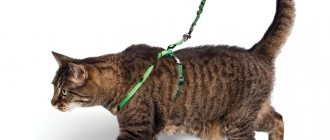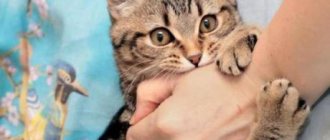Do cats understand human speech?
Cats have lived next to humans for several thousand years, but we still have not fully learned to understand them.
- Most cat owners are interested in the question of whether cats understand human speech.
- Numerous studies show that pets can understand human speech (up to approximately 100 words), but we are not talking about complete understanding.
- Cats only remember individual words, but what they perceive best is the intonation with which these words were spoken. Cats are also good at remembering their name.
Animals clearly sense by their voice when the owner is angry or joyful, sad or angry. Cats behave in accordance with the intonations they hear.
If the owner is angry with the cat, then he stops the unwanted act, and if he affectionately calls him to him, then he goes into his arms.
"Talking" movements of the ears and head
A cat can “tell” a lot of interesting things with its ears, head and whiskers. She can:
- prick or press ears;
- lower, raise your head;
- point the mustache forward and backward.
These animals do not need to move their heads to hear everything that is happening to the side or behind. To do this, they only need to turn their ears in the direction of the sounds. If the ears perk up, it means the cat is very interested in something and is studying the object. When the animal senses approaching danger, the ears are pressed to the head, the tips pointing back. This way the pet protects its ears.
A cat that feels a surge of happiness and trusts its owner walks with its head held high. At the same time, her ears are pricked up, as if she wants to hear praise, compliments addressed to her, to make sure that she is really loved. Raising your head up can be a gesture demonstrating a dominant position. You can also observe a situation when a cat is driven “into a corner” and needs to defend itself. The ears are pressed down.
In a calm environment, a lowered head may indicate a feeling of peace, boredom or drowsiness. Sometimes a cat lowers its head as a sign of humility, submission, if it is attacked by another cat with which it cannot cope.
By the direction of the whiskers you can determine your pet's mood and emotions. If they are pulled back, the animal intends to attack or defend itself. A mustache pointing forward indicates a relaxed, calm state and pleasant emotions.
How does a cat communicate with its owner?
Many cat owners are interested in the question of how to understand a cat. To do this, tailed pets have all sorts of body movements, as well as many sounds. They may use purrs, hisses, soft or loud meows, and other sounds.
In addition, cats communicate with people by extending their claws, turning their ears or head, scratching, biting or rolling on their back. Purring is a sign of pleasure, happiness and calmness. It is possible that your kitty needs food, attention or affection.
Living with a cat, the owner will easily begin to notice the difference between the cat's purring. This often depends on the time of day or where the cat is when she purrs.
A growl or hiss indicates that the cat is determined to protect its interests and desires to the last.
How to understand the behavior of cats if your pets want to tell you something using gestures or behavioral patterns? Cat owners know very well that tails are the most expressive and emotional organs of their pets.
- Thanks to the movements of the tail, animals clearly demonstrate their desires or mood.
- Waving the tip of its tail - a cat shows everyone around that it is very interested in something.
- Waving its tail indicates that the pet is very worried.
- If a cat holds its tail up, it means that the pet is very surprised or in a fighting mood.
- But a drooping tail is a symptom of depression or a sign of fatigue.
In the case when a cat clamps its tail between its hind legs, this is a manifestation of fear or fright. A relaxed and motionless cat's tail expresses that the pet is in a great mood.
The arched back and the fur standing on end demonstrates a threat. This is how the cat wants to appear larger than he really is. Most often, a cat scares a dog with this look. If she keeps her head straight, then she is not afraid of her opponent.
Voice signals
Most often, cats convey information using their voice. This is how they protest, threaten, beg for a treat, or attract attention. For each situation, the cat has a corresponding set of sounds. The vocal abilities of cats are very impressive. In terms of pitch, the animal can produce sounds in the range from 75 to 1520 Hz. Fear and aggression sound “low,” while higher sounds are used to express pleasure and tenderness. The mother cat generally communicates with kittens in the ultrasonic range, which the human ear cannot perceive.
There are at least sixteen different sounds used by cats. Moreover, the “talkativeness” of a cat may depend on the breed. For example, Siamese and Oriental cats “communicate” most often. Purring and rumbling are generally characteristic only of small cats; their larger counterparts practically do not use such sounds.
The purr of a cat is a symbol of sympathy and good-natured disposition. Purring, the cat calls the kittens. Rumbling, on the contrary, warns kittens about danger, and the cat also communicates its aggressiveness and readiness to get into a fight.
Oddly enough, hissing is not a sound of aggression, but rather a symbol of fear and the inability to escape. If snorting and hissing are accompanied by forward movement of the body, this is a signal for a fight. But more often, snorting indicates doubt: fight or run?
Cats rarely resort to a signal such as teeth chattering. Basically, this is a reflex when seeing prey that is out of reach of the animal. The cat chatters her teeth when she teaches her kittens to hunt, literally “I see prey!”
A cat's meow is a conversation. Vowel sounds express a request, complaint or bewilderment, for example, “let me out”, “I’m hungry”, “I’m bored”, “help”. Each cat is individual in the manner of meowing.
Newborn kittens acquire their “vocal” abilities gradually, learning from adult animals. As a rule, a kitten can produce a full range of sounds by the age of three months. Further, the palette of sounds can be enriched under the influence of personal experience, training and the external environment.
Signs of cat love
How to understand that a cat loves you? Feline behavior experts believe that pets truly love their owners and enjoy being with them.
Below are signs that indicate your indoor cat has a strong attachment to you:
- The pet rubs against your legs or arms. This is the main sign that he has accepted you into his inner circle;
- The cat simply follows the owner's heels;
- Your pet kneads its front paws on your stomach or shoulder;
- He shows his belly to the owner, and this is the main sign of pleasure and complete trust.
Licking the owner’s ears or hair also speaks of a cat’s love. This type of “care” is an undeniable manifestation of warm feelings for the owner.
Ears
What can a cat’s ears “tell” about?
Pricked Ears
This is a gesture that the cat is showing interest in what she hears around her. You must have noticed how cats move their ears to hear what is happening behind them without turning their head.
Ears pressed to the head
If the ears are pressed to the head and their tips are directed back, this means that the cat senses danger and is trying to protect its ears in a similar way.
Other signs of cat favor
Cats often hide from strangers or even hiss at them, but they treat their own people more kindly. The cat's slowly closing eyes, the desire to play with the owner, and the location next to him on the sofa speak about a cat's trust and love. They understand very well who is their friend.
Communication by smells
At first glance, it may seem that we are talking about marking territorial boundaries. But this is not entirely true, because there is also a secret type of communication between a pet and its owner using smells.
The most important aromas with which a cat establishes contact with its owner are the elusive odors left by the animal on a person with the help of specific glands located on the chin, forehead and lips.
These glands produce special odors used for greeting (a cat pokes its face after a long absence of its beloved owner). Cats often rub against the owner’s legs, leaving as much odor as possible on the owner’s clothes, and they also rub their muzzle into the person’s face and hands in order to leave more odor on the skin.
After such secret manipulations, a person receives a whole spectrum of specific odors that accompanies him everywhere. Cats believe that the owner also marked them when he stroked their fur or head, leaving their scent in return as a sign of devotion and love.
How to determine if a cat is sick
It is necessary to learn to distinguish a sick cat from a healthy one. This will help to provide her with feasible and timely assistance, and, if necessary, tell the veterinarian about the symptoms of the disease and the pet’s behavior. How can you tell if your cat is sick?
- When communicating with a pet, you should regularly check its teeth and gums, ears, and the condition of its eyes and skin.
- A serious sign of ill health is a cat losing weight.
- Another important symptom of visiting a veterinarian is a change in your pet’s behavior.
If the cat has become lethargic and apathetic, gets tired quickly, and also has an impaired appetite, then these are sure signs to visit a veterinary clinic with your pet.
In principle, any disturbance in the pet’s diet should alert the owner. The cat may start eating more or less - most likely she has health problems. She may also not eat at all for several days - then you need to urgently take her for a consultation with a veterinarian.
- You also need to pay attention to whether the cat takes care of itself.
- After all, they are very clean animals and love to lick their fur.
- Therefore, if your pet does not pay attention to grooming, then he probably does not feel completely healthy.
Research on cats' moods, feelings and emotions is much inferior to that of dogs, but their quantity and quality has been steadily increasing over the last decade. And although these observations are only at the beginning of their journey, they already demonstrate that the ability of cats to communicate with humans is a very complex and multifaceted thing.
To figure out whether cats understand people, you need to learn to master their language. This will allow you to establish the most trusting emotions with your pet. Respectful and close relationships in return for respect and love.
Sight
The eyes can tell you what your cat is feeling right now.
Stare, eyes wide open
This look is usually seen in cats that are fighting, or in cats that are about to attack another cat, an animal, or a person. In this way, they try to scare the enemy.
Squinted gaze, blinks eyes slowly
The meaning of this gesture is opposite to that described above. The cat says that it likes the presence of another animal or person. She trusts them completely.
Have you ever wondered why cats, when in the same room with several people, immediately rush to the person who does not like cats? The reason for this is the look.
The eyes of cat lovers will be drawn to the cat, which makes it feel threatened and will try to stay away from them. A person who doesn't like cats won't want to look at her because he sincerely hopes that the cat won't get in his way. The cat sees such a person as the only harmless creature in the room, so can you guess who it will run to?!











